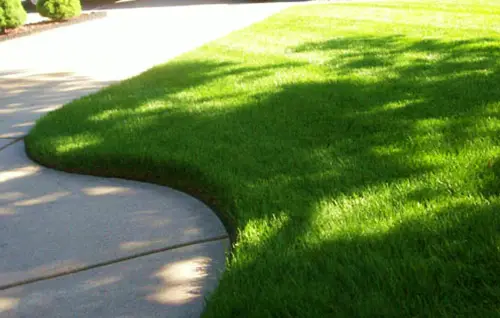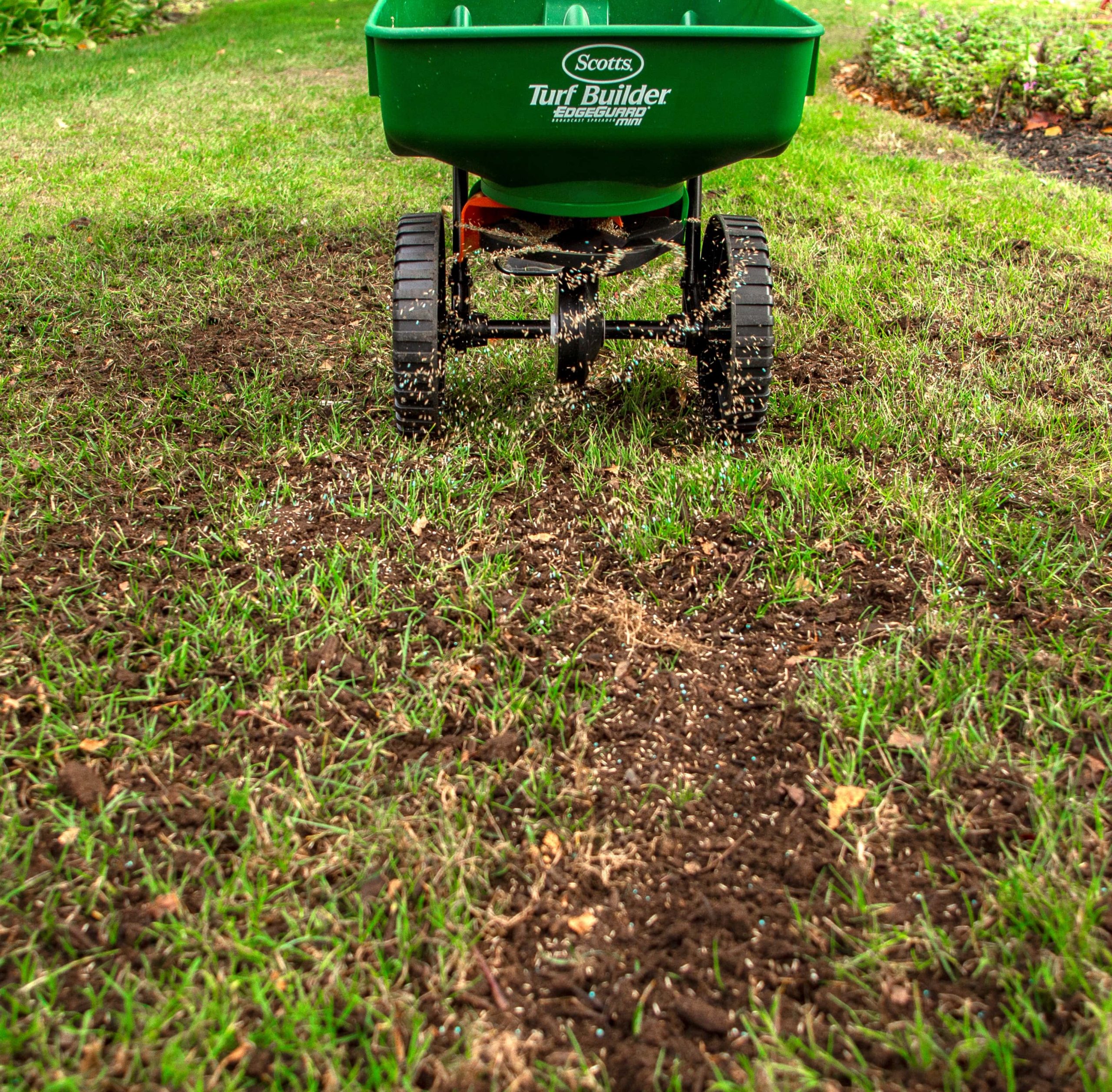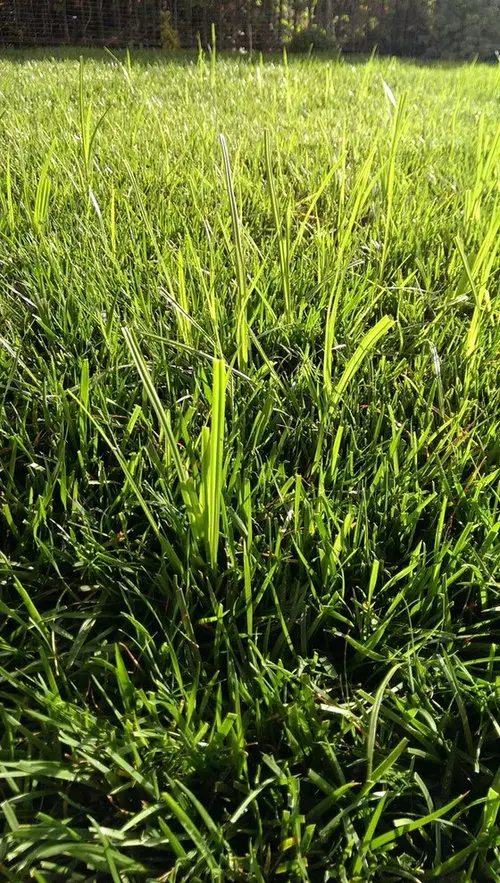How To Care For Kentucky Bluegrass
Do you struggle to keep the Kentucky bluegrass in your lawn green in the summer months? Are you seeing what looks like lighter-colored, delicate little weeds growing in your lawn? If you answered yes to either of these questions, this post will help you learn more about your lawn and how to take care of it.
Skip to a Section:
Scalp Bermuda Grass In Spring
In regions where Bermuda grass goes dormant in winter, mowing especially low just before the grass exits dormancy can provide huge benefits. Scalping removes dead grass and thatch, eliminating grass diseases and promoting new, thick growth. To properly scalp your yard, do the following:
- Scalp just before green-up, when soil temperatures reach 60 .
- When scalping, set your mower blade to the lowest height. Ideally, you should be cutting your Bermuda grass at 0.5 inches.
- Bag all thatch and dead grass resulting from the scalping. This will prevent the dead material from smothering new grass growth.
Does Cutting Grass Make It Spread
A lush, thick lawn is the goal for many homeowners, and why wouldnt it be? It looks nice, it feels nice, and it will keep the weeds out on its own, making your maintenance work easier! But your lawn is patchy and you wonder how to get your grass to spread?
Cutting grass will encourage it to spread. The speed that your grass spreads usually depends on your type of grass. Some grasses spread quickly by sending out runners. Other types of grass dont spread as fast. Either way, cutting grass encourages it to put its energy into roots and new shoots instead of height. This will help your grass to both spread and thicken.
Whats the best way to get your grass to spread and thicken, and how does your mowing affect it?
Read Also: Wild Violets Killer
Purpose Of Overseeding A Lawn
Lawn care professionals will frequently use overseeding as a preventative measure. Instead of waiting for the thin areas or bare spots to appear, they will reseed the lawn so that the new grass plants appear before the weak areas are able to develop. Rather than fixing a poor-looking lawn, this proactive approach keeps the turf looking full, green, and healthy.
The second reason for overseeding is to bring up color when warm season grasses go dormant in winter. This is done by seeding the warm season lawn with a cool season grass seed mix that will produce color during those months when the warm season grasses are dormant. It may seem odd to plant cool season grass seed on a warm season lawn but the very conditions that cause the warm season grass to go dormantmilder daytime conditions and cooler nighttime temperatureswill allow the cool season grass to thrive, if only temporarily. The desired result is year-round green color.
How Often Should You Get Your Lawn Mowed

You should have your lawn care company mow your lawn at least once per week during the growing season. If you have time to get a second mow in, particularly during the peak growing season like mid-to-late spring, that would be optimal. Set the desired height on your mower and try to never cut off more than one-third of the grass at one time.
Other questions to ask yourself:
- What is my grass type?
- What is the optimal height for that grass type?
- How long does it take to mow my yard?
- Can I schedule 1-2 days per week to mow?
Also Check: How Much Is Trugreen Lawn Service
Dethatch During The Growing Season
Dethatching is good for a Bermuda grass lawn if it is done during the active growing season and only when the thatch is more than 1/2 inch thick. If you dethatch when Bermuda grass is dormant, it can easily kill the lawn or leave it thin and sparse.
Id recommend that you overseed your bermudagrass lawn to get it to thicken up faster if you dethatched with a power rake during the slow-growing or dormant season.
While overseeding a bermudagrass lawn is best done in September or in the fall, you can do it early in the spring as soon as the grass gets out of dormancy. This will help fill in the bare and thin spots that were caused by heavy dethatching during dormancy.
Mow Lower More Frequently
Set your lawn mower lower slightly lower than 1.5 inches when mowing Bermuda grass to discourage vertical growth and encourage more lateral growth. Increased lateral growth of grass stolons helps fill in the bare spots, making your lawn grow thicker and fuller quickly.
Bermuda grass is an aggressive turfgrass and can grow to 4-12 inches tall if not mowed. However, you want to make it grow and spread nicely to form a dense carpet. Therefore, push it to grow more laterally than vertically.
Pro tip: Be careful not to mow too low and risk scalping and damaging your lawn. The recommended mowing height for Bermuda grass is 1-1.5 so set the mower anywhere between 0.5 and 1 inch low when youre going for a fuller lawn.
Other tips for making your Bermuda lawn grow thicker by mowing include:
- Use a reel mower for bermudagrass for a much cleaner cut. I use and recommend the Fiskars StaySharp Reel Mower for this.
- Keep your mowers blades sharp to prevent hacking the grass blades and exposing the turf to disease.
- Mow every 5 to 7 days and less often when the lawn is drought-stressed.
If youre feeding your lawn properly and mowing as Ive recommended above, your turf will soon fill in and become thicker and fuller quite fast.
Don’t Miss: Lawn Mowing Estimates
How To Get A Thicker Lawn And Keep It
Thicker, lusher, healthier and more beautiful. If those words describe your lawn goals, success may be closer than you think. Transforming thin, lackluster grass into a thicker, healthier lawn isn’t difficult to achieve. With three easy stepsor one simple, three-in-one lawn boostyou can get a thicker lawn and put thin grass behind you. Then add three best practices to keep a thicker lawn, and you’ll enjoy a lawn that looks and feels great for years to come.
How to Get a Thicker Lawn:
Next Steps You Can Take To Make Grass Thicker And Fuller
There are a few core lawn maintenance projects that you can complete to improve the condition of your lawn.
Anyone asking how to make grass thicker and fuller probably has a yard that would benefit from these three projects, and you can do all three at the same time in a single weekend.
Early in the fall is the best time to tackle these projects, though spring can work too.
Read Also: How To Fix Dead Patches In Lawn
How To Make Bermuda Grass Thicker
The best way to make Bermuda grass thicker is to feed the lawn with slow-release nitrogen fertilizer such as Milorganite, then water it once per week to improve its growth rate. Also, mowing slightly lower will improve lateral growth and make the lawn thicker and fuller.
Here are 8 steps to make Bermuda grass grow thicker and fuller:
How To Thicken Your Lawn
Gro-Sure has a wide range of lawn seed for all your lawns needs, including shady conditions, hard-wearing, fine lawns, or fast-establishing. Plus, our seeds have a bird deterrent coating to maximise your success. For best results sow in the spring from March to May, or in early autumn from mid-September to mid-October depending on weather conditions.
Read our guide on how to thicken your lawn below, or watch the video.
Don’t Miss: Can You Hydroseed Over An Existing Lawn
Will New Grass Thicken
4/5young lawnthickennew lawncanwillnewcanlawn
Moreover, why is my new grass so thin?
Some causes for thin, patchy grass include: Compacted or hard soil. If your soil is too hard , it creates a hostile environment for growing grass. As a result, roots lack air and are not able to access the nutrients they need to grow.
Additionally, how long does it take for new grass to thicken up? Water your lawn immediately after sowing the grass seeds. Soak the soil to a depth of several inches, and keep it moist as the grass seed germinates. Depending on the grass type, germination can take between four and 14 days.
Besides, will new grass get thicker?
New grass fills in between what’s already there, creating a thicker, lusher feel and look. Routine overseeding is the pro secret to a great lawn. Fall and spring are the best times for overseeding cool-season northern lawns, while thin warm-season southern lawns are best seeded in late spring.
How do you get grass to thicken?
How to Thicken your Lawn
Does Frequent Mowing Thicken Grass

Frequently mowing your yard, , does help to thicken your grass. As long as you dont cut more than 1/3 off the top, and keep the total leaf height to at least 5cm, regular mowing keeps your grass healthy, and promotes lateral growth. When you stop grass from being able to grow taller, it redirects the energy into sending off new shoots, resulting in thicker grass!
Another way you can promote thicker lawn with your mowing, is to mow in different directions. When you mow the lawn along the same route every time, you train the grass blades to grow that way. By changing it up, and mowing from different directions, you will encourage the leaves to stand up straight. This means that theres more space for new shoots to grow alongside the current ones, so your lawn grows thicker .
Recommended Reading: Battery Powered Lawn Edger
How Do I Make My Grass Grow Thicker
Feel like your grass grows quickly, but never really looks that great because its too sparse?
You might notice your neighbours lawn always looks thick and lush, but yours, even though its the same variety, just doesnt quite look the same.
There are many factors that could be contributing to your lawns poor performance. The main culprits are shade, compaction or a pest related issue. Look as these potential issues first to rule these out as the problem. If you dont, the underlying problem will continue to cause you headaches and you will never get the result you are looking for.
If you have ruled out shade, compaction and pests, it could simply boil down to a difference in mowing techniques. A few tweaks to the way you mow your lawn and the frequency can make all the difference.
Ways To Get Thicker Greener Grass: Pro Lawn Care Tips For Central & Southern Md
Hows your lawn looking these days? Do you wish you had thicker and greener grass?
Youre not alone. Everyone covets those luxurious lawns that beg to be walked on with bare feet while sipping an iced cold drink.
Maybe you look over at your neighbors yard thinking the grass is always greener on the other side of the fence or property line. Well, worry no more. These pro lawn care strategies can amplify your lawns health and make the grass greener on both sides of the fence maybe yours will even be a little greener.
Read Also: When To Fertilize Lawn In Iowa
The Importance Of A Lawn Soil Test
A soil test is a crucial step in finding out what nutrients your lawn is lacking and what fertilization and any other treatments can do to improve its density and color.
For instance, if your soils pH is off, then the fertilizer youre feeding it might not be working at all on your quest for greener grass. Poor pH could limit nutrient uptake.
In Central and Southern Maryland, lawns tend to lean on the acidic side. Limestone applications can help to correct your soils pH and bring it back in balance.
Also, only some lawn care professionals like Natural Green Systems Lawn & Pest conduct free soil tests on their customers properties to ensure the custom program they develop for each lawn meets that lawns specific needs.
How To Sow A New Lawn From Seed
Sowing a new lawn from seed is a great way of creating a cost effective lawn, but it important to consider the time of year you are doing it, carry out correct preparation and be patient as the lawn establishes over several months.
Lawn Seeding can be done by professional contractors such as Lawntechs sister company Hewlett Turf & Landscapes or you can do it yourself with a little time and effort.
Read Also: How To Revive Brown Lawn
How To Thicken Up Your Lawn
Many homeowners are embarrassed by the poor state of their lawns, which may be a result of inadequate care or improper seeding. If you want to achieve the look of a thick, green lawn, all you may need to do is fertilize or occasionally overseed the area. These methods are straightforward enough that virtually any homeowner can accomplish them without the help of a lawn service. If your lawn is in very poor shape, however, it may be better to start from scratch, replanting the lawn properly and taking steps to keep it thick and luscious.
How To Plant A New Lawn From Seed
The least expensive way to start a lawn is by seed. Starting a lawn from seed is a snap, especially on an area that is relatively flat. The biggest task is preparing the site and making sure the soil is of good quality. Choosing the right seed is a matter of looking at your yard and your climate. In general there are two broad types of grass: cool season and warm season, each named for the climate and temperature in which it grows best. If you are in a definite warm or cool climate, you can zero in on the grass that will work best for you.
Step 1Step 1Measure the Yard and Buy Seed
Measure the size of the yard then buy the seed you needthe exact amount will depend on the variety of grass, as well as the size of your yard. A few days before planting, water the lawn to a depth of 6 to 8 inches. Plant when the surface of the soil is dry.
Step 2Step 2Prepare the Lawn
Kill the existing grass, rake out debris, grade the yard, and enrich the soil before planting. Give the soil its final grading right before planting.
Step 3Step 3Lay Out an Area of the Lawn
Seed is applied at a rate of so many pounds per 1,000 square feet, depending on the seed. Because drop spreaders are calibrated for fertilizer rather than seed, you’ll have to lay out an area of 1,000 square feet on your own. If the area is irregular or involves several parts of the lawn, mark the boundaries with flour, chalk, or landscapers paint.
Don’t Miss: Average Trugreen Cost
Seed And Feed On The Same Day
Which goes on first, the seed or the lawn food? It’s up to you. Either way, use a drop or rotary spreader. Just follow the settings on the packages. You want to feed on the same day with Scotts® Starter® Lawn Food for New Grass to give your new grass seedlings a head start.
Cover Up
After the seeds and Starter® lawn food are laid down, cover the seeds with a thin layer of Scotts® Turf Builder® Lawn Soil. You can do this by gently dragging the back of a leaf rake over your seeded area. On hills, mulch with a thin layer of straw to keep seeds from washing away. Make sure you can plainly see the seedbed beneath the straw. You can also mulch with straw on the rest of your new lawn to help cut back on water use.
Keep on watering
After all your efforts, you don’t want your grass seed to dry out. Make sure the top inch of soil in your new lawn stays moist. You may need to lightly water two or three times a day. Keep at it until your seedlings are well-established. Once your new lawn has reached a mowing height, you can reduce the frequency and start watering thoroughly once or twice a week.
Maintenance
Great, your new lawn is growing vigorously. Now you have to cut it. Make sure you only mow the top third of the grass blades. Adjust your mower to high setting to keep the lawn nice and thick. When you cut it too short, weeds can sneak in.
How Often Should You Mow Your Lawn In The Spring

For a healthy lawn, you should mow your cool-season grasses at least once per week in the early spring , and twice per week when the grass is more actively growing in the mid to late spring . Cool-season grasses grow very fast this time of year. The perfect outside and soil temperatures, coupled with feedings of nitrogen fertilizer will lead to fast growth. Gas up your mowers and get ready to mow!
You May Like: Oil Drain Tube For Craftsman Riding Mower
Give Your Grass The Mowing It Deserves
Mowing the lawn might not be your idea of a good time, but regular mowing maintenance can help to keep your grass healthy. Make sure the mower blades are sharp to avoid tearing the grass. Tearing the grass can cause it to dry out easier, and makes it more susceptible to disease.
Make sure you rake and clean up grass clippings to make sure that decaying grass doesnt choke healthy grass and lead to a chemical imbalance.
